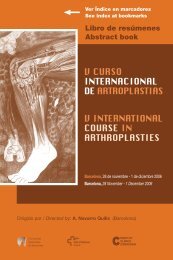Notas / Notes - Active Congress.......
Notas / Notes - Active Congress.......
Notas / Notes - Active Congress.......
You also want an ePaper? Increase the reach of your titles
YUMPU automatically turns print PDFs into web optimized ePapers that Google loves.
MIÉRCOLES / WEDNESDAY<br />
88<br />
REVISION STRATEGY AT<br />
THE FEMORAL LEVEL<br />
Laurent Sedel<br />
Hôpital Lariboisiere (APHP) and University<br />
of Paris (France)<br />
Femoral revision is frequent, due to femoral loosening , thigh<br />
pain, recurrent dislocation, osteolysis or sepsis. Whatever<br />
the reason, with the exception of some difficult septic cases,<br />
our strategic approach is similar. Some of our expertise concern<br />
femoral stem retrieval. Our reconstruction strategy is<br />
different if we are revising total hip in active and young patient<br />
or if it is an old and inactive one.<br />
First step is always a large “en bloc” tissue excision. For old<br />
and inactive, it is sometimes possible to retain the stem if<br />
not loosened and perform an “in cement” cementation; In<br />
this group we select usually metal or alumina on polyethylene<br />
couple and cemented implants; In young and active, we select<br />
alumina on alumina combination which resumed in<br />
cementless acetabular fixation, and cementless or cemented<br />
stem depending on stem retrieval method.<br />
Stem retrieval of a well fixed cementless stem is performed<br />
via a large transtrochanteric approach associated with a transfemoral<br />
one. Repair is performed using cerclage and long<br />
cemented stem with or without HA/TCP granules impacted.<br />
Cement retrieval is at the moment performed since 4 years<br />
using Ultra sound (Oscar*) material, which in our hand is very<br />
successful specially for retractor retrieval. This allows easy<br />
retrieval without fenestration. Then medullary canal is reamed<br />
in order to receive either a cemented or sometimes a cementless<br />
stem, depending on the bone quality.<br />
Frequently we used a modified Link technique replacing<br />
allogenic morcellised bone by hydroxyapatite granules (45<br />
cases). This can be done either with a cemented or a cementless<br />
stem.<br />
In case of very severe bone loss and osteolysis, we performed<br />
massive allogenic bone transplant associated with long cemented<br />
stem and distal HA granules with cement. (18 cases).<br />
As we usually performed one stage revision for septic cases,<br />
strategy is not different; It is only in selected cases with many<br />
sepsis recurrences and specially aggressive bacteria that<br />
we performed a two stage procedure.<br />
Our goal is always to get a step down to keep the maximum<br />
living bone; and also to get the best functional outcome permitted.<br />
RESULTS WITH CEMENTLESS STEM<br />
REVISION<br />
Karl Zweymüller<br />
Orthopädische Krankenhaus Gersthof,<br />
Wien (Austria)<br />
THE MANAGEMENT OF PERIPROSTHETIC<br />
FEMORAL FRACTURES UTILIZING<br />
A CEMENTLESS TOTAL HIP REVISION<br />
SYSTEM WITH MODULAR DISTAL<br />
FIXATION<br />
Robert A. Fada, MD; Jose A. Rodriguez, MD; Thomas K.<br />
Tkach, MD; Tyler McKee, DO; Jodi F. Hartman, MS; and<br />
Michelle L. Wright, BS<br />
Lenox Hill Hospital. New York (USA)<br />
Periprosthetic femoral fractures after total hip arthroplasty<br />
are increasing in frequency and pose a significant technical<br />
challenge to the orthopaedic surgeon. The purpose of this<br />
study was to perform a multi-center, retrospective review of<br />
periprosthetic femoral fractures managed with a specific<br />
cementless, corundumized, modular revision femoral component<br />
and report the results at a minimum 1-year follow-up.<br />
Pre op planning is performed to try and predict the implant<br />
length and depth of penetration. When possible, a 5 cm extent<br />
of bone contact is sought within the distal fragment. The<br />
surgical technique involves removal of the implant in place,<br />
using the fracture site to gain access to any remaining points<br />
of fixation. When necessary for proximal spot welds, the<br />
proximal fragment can be split longitudinally as in a Wagner<br />
technique to allow access to the fixation points. The fracture<br />
is exposed only to the extent necessary to allow implant extraction<br />
and obtain reduction. Every attempt is made to protect<br />
the quadriceps fibers attachment, particularly to the distal<br />
fragment. The distal fragment is reamed through the fracture<br />
site to assure proper positioning, and checking the reamer<br />
position using an image intensifier. Once distal fragment<br />
position and contact is assured, the proximal fragment is<br />
reamed to allow clear implant passage. The distal stem is<br />
then inserted to the predetermined position while maintaining





